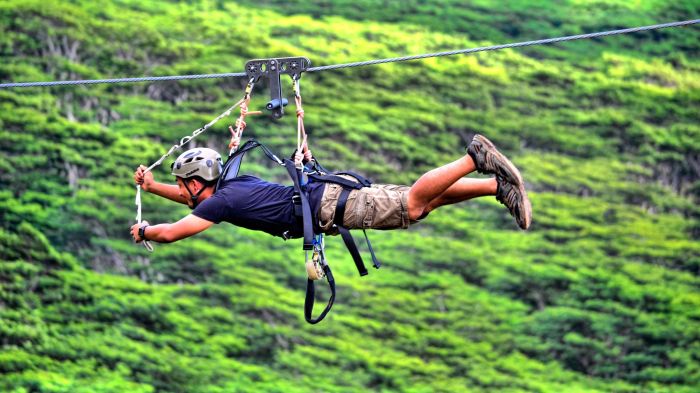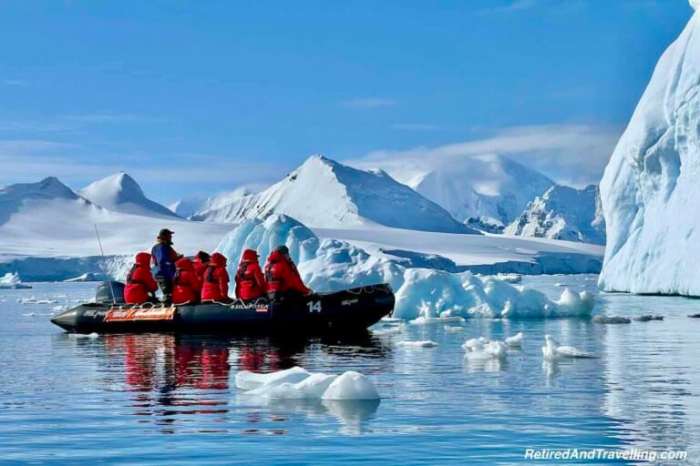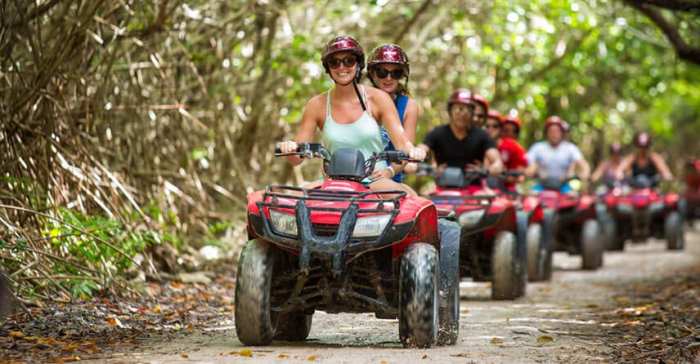Adventure Tours Exploring the Outdoors
Adventure tours offer a thrilling escape into the great outdoors, from challenging hikes to exhilarating kayaking expeditions. These experiences cater to a diverse range of interests and skill levels, providing opportunities for personal growth and unforgettable memories. The history of adventure tourism is rich, evolving from simple excursions to highly organized and professionally managed expeditions. This exploration delves into the intricacies of planning, safety, marketing, and sustainability within the adventure tourism industry.
This comprehensive guide explores the various facets of adventure tours, including diverse activities like rock climbing and wildlife safaris. Understanding the target audience, from seasoned adventurers to those seeking a first taste of outdoor excitement, is crucial. The planning and logistics of a successful adventure tour are meticulously examined, highlighting essential aspects like transportation, accommodation, and crucial safety protocols. Moreover, the document explores the crucial role of marketing and promotion in attracting customers and the importance of environmentally responsible practices.
Introduction to Adventure Tours

Adventure tours offer an exhilarating escape from routine, combining physical activity with exploration of natural landscapes. These experiences are carefully curated to provide a sense of accomplishment and connection with the environment. They cater to a wide range of interests and abilities, enabling participants to push their limits and discover new perspectives.
Adventure tours are designed to provide unique experiences, encompassing everything from challenging hikes to thrilling whitewater rafting. These tours are often focused on the immersive experience, aiming to foster a deep appreciation for nature and the spirit of adventure.
Types of Adventure Tours
Adventure tours encompass a diverse range of activities, each providing a distinct experience. These activities cater to various preferences and skill levels, ensuring there’s an option for everyone.
- Hiking tours often traverse scenic trails, from moderate climbs to challenging multi-day treks. These tours frequently involve breathtaking vistas, offering opportunities for wildlife observation and appreciating the natural beauty of the region.
- Kayaking tours offer a unique perspective of waterways, from calm lakes to fast-moving rivers. They provide opportunities to experience nature from a different angle, often with the possibility of encountering wildlife or navigating through challenging rapids.
- Rock climbing tours provide an exhilarating and challenging experience, often involving guided climbs on various rock formations. These tours cater to climbers of different skill levels, ensuring safety and progression for each participant.
- Whitewater rafting tours provide an adrenaline-pumping adventure, navigating through the currents of rivers. These tours require a degree of physical endurance and adaptability, often offering a memorable and engaging experience.
Historical Context of Adventure Tourism
Adventure tourism has evolved significantly over time, with its roots in early exploration and adventure travel. Early forms of adventure tourism were largely driven by curiosity and a thirst for exploration, with travelers venturing into unknown territories for the sake of discovery. The 20th century witnessed the rise of organized adventure tours, with established companies offering structured itineraries and guided excursions. The advent of readily available transportation and communication facilitated the growth of this industry, enabling access to previously remote locations. Today, adventure tourism is a well-established industry, offering a wide range of experiences and catering to a global audience.
Comparison of Adventure Tour Categories
The table below provides a comparison of various adventure tour categories, considering pricing, duration, and difficulty levels. This table offers a quick reference for individuals considering participating in adventure tours.
| Tour Category | Pricing (USD, approximate) | Duration (Days) | Difficulty Level |
|---|---|---|---|
| Beginner Hiking | $300-$500 | 2-3 | Easy |
| Intermediate Kayaking | $400-$700 | 2-4 | Moderate |
| Advanced Rock Climbing | $800-$1500 | 3-7 | Difficult |
| Whitewater Rafting | $500-$1000 | 2-5 | Moderate-Difficult |
Target Audience and Demographics
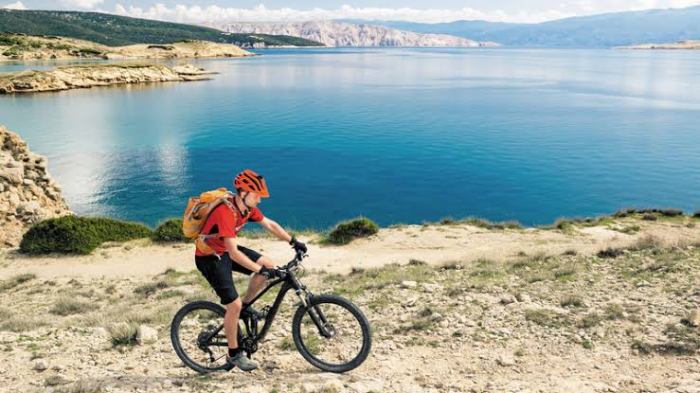
Source: kazakhstan-tourist.com
Adventure tours cater to a diverse range of individuals seeking unique experiences and physical challenges. Understanding the typical participant profile is crucial for tailoring tour offerings and ensuring a positive experience for everyone involved. This section details the characteristics, motivations, and demographics of those who choose adventure tours.
Typical Participant Profile
The typical adventure tour participant is generally an active individual seeking an immersive experience in nature or a challenging environment. They appreciate the opportunity to push their limits while enjoying the camaraderie of a group. They value experiences over material possessions and often possess a thirst for exploration and discovery. A strong sense of adventure, coupled with a willingness to embrace new challenges, is a common thread among participants.
Motivations and Interests
Participants are often drawn to adventure tours by a desire for personal growth and self-discovery. The thrill of conquering a challenging activity, the sense of accomplishment, and the opportunity to learn new skills are key motivators. The natural beauty of the destinations, the opportunity to connect with nature, and the chance to meet like-minded individuals also contribute significantly to the appeal of these tours. The social aspect is also significant, with participants often enjoying the shared experience and building friendships.
Age Range, Experience Level, and Physical Fitness
Adventure tours cater to a broad age range, from young adults to seasoned retirees. The age range frequently overlaps with the level of experience and physical fitness. While some tours cater to beginners, others are geared towards more experienced participants. The tours themselves are often carefully designed to suit varying experience levels, with a focus on gradual progression and appropriate challenges. Participants’ physical fitness levels vary, and the difficulty of activities is usually tailored to accommodate participants’ fitness levels, often with options for different levels of intensity within a given activity. Tour operators often assess physical fitness before a tour begins.
Demographic Breakdown by Activity Type
| Activity Type | Age Range (Approximate) | Experience Level | Physical Fitness | Other Considerations |
|---|---|---|---|---|
| Rock Climbing | 20-50 | Beginner to Advanced | Moderate to High | Requires good upper body strength and stamina. |
| Whitewater Rafting | 18-60 | Beginner to Advanced | Moderate to High | Requires comfort with water and potential rapids. |
| Hiking/Trekking | 25-65 | Beginner to Experienced | Moderate to High | Dependent on the specific trail’s difficulty. |
| Mountain Biking | 18-55 | Beginner to Experienced | Moderate to High | Requires good bike handling skills and stamina. |
| Canyoneering | 25-50 | Intermediate to Advanced | High | Requires experience in navigating natural waterways and climbing. |
This table provides a general overview of the demographic breakdown across different adventure tour activities. Actual participant profiles can vary significantly depending on the specific tour and its location. For example, a beginner-friendly rock climbing tour might attract a wider age range of participants compared to a more challenging whitewater rafting experience.
Planning and Organizing Adventure Tours
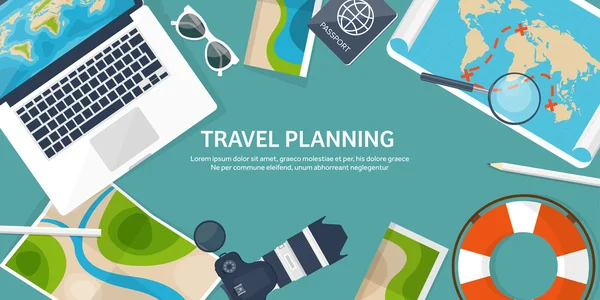
Planning a successful adventure tour involves a meticulous process, from initial concept to final execution. Careful consideration of every detail, from the thrilling activities to the practical logistics, ensures a positive experience for participants and a profitable venture for the tour operator. This process requires a comprehensive understanding of the target audience, the chosen adventure, and the overall operational aspects of the tour.
Essential Planning Steps
A successful adventure tour hinges on a well-defined plan. This begins with a thorough concept development, encompassing the type of adventure, its location, and the target audience. Next, detailed research is crucial to understanding the local environment, necessary permits, and potential risks. Developing a comprehensive itinerary, including specific activities, transportation, and accommodation arrangements, follows. Finally, thorough risk assessment, contingency planning, and pre-trip communication with participants are vital.
Tour Logistics
Effective tour logistics are paramount for a smooth and safe adventure. Transportation plays a critical role, requiring the selection of suitable vehicles and drivers for the chosen terrain and activity. Accommodation needs careful consideration, ensuring the suitability of lodging options for the duration of the tour, considering comfort and safety. Essential safety protocols, such as emergency contact procedures and first-aid provisions, must be clearly defined and readily available to participants.
Example Itineraries
Different adventure activities demand unique itineraries. A trekking tour in the Himalayas, for example, would require a detailed plan encompassing acclimatization hikes, challenging treks, and the management of altitude sickness. A whitewater rafting tour on the Colorado River would necessitate careful navigation of the rapids, safety briefings, and appropriate safety equipment. A kayaking trip in the Pacific Northwest, meanwhile, would involve careful navigation of tidal currents, potential wildlife encounters, and the provision of appropriate equipment and expertise.
Safety Protocols
Safety protocols are not an afterthought but an integral part of every adventure tour. This involves pre-trip briefing sessions for participants, highlighting safety procedures, emergency contacts, and potential risks. Proper first-aid kits and trained personnel must be readily available. A thorough risk assessment should identify potential hazards, such as weather conditions, terrain challenges, and equipment malfunctions. Contingency plans should be in place to address unforeseen circumstances.
Flowchart of Adventure Tour Planning
| Stage | Description |
|---|---|
| 1. Concept Development | Defining the type of adventure, location, and target audience. |
| 2. Research and Permissions | Gathering information on the location, necessary permits, and potential risks. |
| 3. Itinerary Creation | Develop a detailed schedule of activities, transportation, and accommodation. |
| 4. Risk Assessment | Identifying potential hazards and creating contingency plans. |
| 5. Logistics Planning | Arranging transportation, accommodation, and necessary equipment. |
| 6. Participant Communication | Providing pre-trip information and instructions. |
| 7. Tour Execution | Monitoring the tour, addressing issues, and ensuring participant safety. |
Sustainability and Environmental Impact
Adventure tourism, while offering exciting experiences, carries a responsibility to minimize its environmental footprint. Sustainable practices are crucial for preserving the natural beauty and biodiversity that attract tourists and ensure the long-term viability of adventure activities. This section delves into the environmental considerations and sustainable strategies vital for responsible adventure tour operators.
Environmental stewardship is paramount in adventure tourism. Operators must prioritize the well-being of the natural environment, understanding that their actions have a direct impact on ecosystems and local communities. This involves careful planning, resource management, and a commitment to minimizing negative consequences.
Environmental Considerations
Adventure tours, by their very nature, often involve interacting with delicate ecosystems. Operators must be mindful of their impact on flora and fauna, considering the potential for habitat disruption, pollution, and disturbance to wildlife. This awareness includes respecting wildlife behaviors and avoiding unnecessary noise or light pollution. Careful route planning and adherence to established trails are essential.
Sustainable Practices in Adventure Tourism
Minimizing the ecological footprint of adventure tours is achieved through a range of sustainable practices. These practices extend beyond simply reducing waste; they encompass the entire operation, from sourcing materials to managing visitor impacts.
- Waste Reduction and Recycling: Implementing comprehensive waste management systems, including recycling programs and minimizing single-use plastics, is crucial. This involves educating tour participants about responsible waste disposal and providing readily available recycling options.
- Water Conservation: Water is a precious resource, especially in many adventure destinations. Adventure tour operators should prioritize water conservation in all aspects of their operations, from reducing water usage in accommodations and facilities to educating participants on responsible water use.
- Energy Efficiency: Reducing energy consumption through the use of renewable energy sources, energy-efficient equipment, and promoting public transportation for staff and participants significantly reduces the carbon footprint.
- Local Community Involvement: Supporting local businesses and communities through partnerships and economic opportunities is vital. This includes hiring local guides, sourcing supplies locally, and promoting responsible tourism practices within the local culture.
Eco-Friendly Adventure Tour Operators
Numerous tour operators are leading the way in sustainable adventure tourism. These operators prioritize environmental protection and community well-being, demonstrating how responsible practices can be integrated into every aspect of the operation.
- Example 1: [Insert Example Operator Name] focuses on responsible wildlife viewing, minimizing noise pollution during wildlife interactions, and partnering with local conservation organizations for impactful conservation efforts.
- Example 2: [Insert Example Operator Name] utilizes electric vehicles for transportation, employing local guides, and investing in sustainable infrastructure within the region. This demonstrates a commitment to reducing emissions and promoting local economies.
Benefits of Responsible Tourism, Adventure tours
Responsible adventure tourism offers substantial benefits for preserving natural environments. By minimizing impact and promoting conservation, these practices contribute to the long-term health and beauty of destinations. Moreover, responsible tourism fosters a sense of stewardship and appreciation for the environment among both operators and participants.
- Protection of Biodiversity: Responsible practices, such as habitat preservation and wildlife monitoring, directly contribute to safeguarding biodiversity.
- Environmental Conservation: Reducing pollution and minimizing ecological damage ensures the long-term health of the natural environment.
- Community Empowerment: By supporting local communities, responsible tourism fosters economic growth and development while preserving cultural heritage.
Environmental Guidelines for Adventure Tour Operators
Adherence to clear environmental guidelines is crucial for responsible adventure tour operators. These guidelines provide a framework for minimizing negative impacts and promoting sustainable practices.
- Minimize Footprint: Develop detailed plans to minimize the environmental impact of tours, considering all stages of the operation, from transportation to waste management. Establish clear procedures for waste disposal and resource use.
- Respect Wildlife: Ensure strict adherence to wildlife observation guidelines, minimizing disturbance to animals and their habitats. Provide training for tour guides and participants on respectful wildlife interactions.
- Partner with Locals: Seek partnerships with local communities, businesses, and conservation organizations. Engage with local stakeholders to incorporate their knowledge and expertise into the tour design.
- Promote Awareness: Educate participants about the importance of responsible tourism and the unique environmental challenges of the destination. This includes providing information about the region’s ecosystems and cultural heritage.
Technology and Innovation in Adventure Tours

Technological advancements are rapidly reshaping the adventure tourism landscape, enhancing safety, convenience, and overall visitor experiences. From streamlining booking processes to creating immersive virtual realities, technology is transforming how we plan, execute, and enjoy these trips. This evolution allows for greater accessibility and caters to a wider range of adventure seekers.
Transforming the Adventure Tourism Industry
Technology is significantly impacting the adventure tourism industry by automating tasks, improving communication, and creating more interactive experiences. This encompasses everything from online booking platforms to real-time tracking and safety features. The use of technology is improving the efficiency of operations, lowering costs, and enhancing the overall travel experience for participants.
GPS Tracking
GPS tracking systems are increasingly integrated into adventure tours, offering enhanced safety and real-time monitoring capabilities. This allows for precise location identification and route management, facilitating rapid response in case of emergencies. The data collected can also be used to analyze routes and optimize future expeditions. For example, expeditions utilizing GPS tracking can easily monitor the progress of participants, identify potential hazards, and react promptly to any issues.
Online Booking Systems
Online booking systems have become essential for managing bookings, providing accurate information, and facilitating secure transactions. They streamline the entire process from initial inquiries to final payment, making the booking experience seamless for both operators and tourists. These systems often include interactive maps, detailed itineraries, and secure payment gateways. This ease of access and convenience is driving greater participation in adventure tours.
Virtual Reality Experiences
Virtual reality (VR) and augmented reality (AR) are revolutionizing the adventure tourism industry by offering immersive pre-trip experiences and interactive post-trip reviews. Pre-trip VR simulations allow potential participants to virtually explore the terrain, encounter the environment, and prepare for the physical challenges of the tour. Post-trip VR allows for a deeper engagement with the memories and experiences from the trip, promoting lasting impressions.
Emerging Trends and Innovations
Emerging trends in adventure tourism include personalized experiences, sustainable practices, and the integration of wearable technology. Personalized experiences, tailored to individual preferences and needs, are becoming increasingly popular. This includes offering diverse activity options and accommodating various fitness levels. Sustainable practices are becoming a core component of many tours, aiming to minimize environmental impact. Wearable technology, like fitness trackers and communication devices, is becoming increasingly integrated into adventure activities.
Comparison of Traditional and Modern Adventure Tour Experiences
| Feature | Traditional Adventure Tour | Modern Adventure Tour |
|---|---|---|
| Booking | Often through travel agents or direct contact. | Online platforms, secure booking systems. |
| Safety | Limited real-time tracking, basic communication methods. | GPS tracking, real-time communication, and emergency response systems. |
| Experience | Mostly physical exploration, limited technology integration. | Immersive VR/AR experiences, personalized itineraries. |
| Sustainability | Often lacking specific sustainability measures. | Emphasis on eco-friendly practices, local community involvement. |
| Accessibility | Limited access for diverse groups. | Enhanced accessibility through diverse tour options, accommodations, and online resources. |
Case Studies and Examples
Examining successful adventure tour companies provides valuable insights into effective strategies, marketing approaches, and factors contributing to their achievements. These case studies offer practical examples that can inspire and inform the development and execution of similar ventures.
Successful adventure tour operators frequently leverage a blend of innovative approaches, meticulous planning, and a deep understanding of their target audience. Their experiences highlight the importance of sustainable practices, technological integration, and the careful consideration of environmental impact.
Successful Adventure Tour Companies
Several companies have achieved significant success in the adventure tourism sector. These organizations often exhibit unique selling propositions that resonate with their target audience, attracting and retaining customers. Factors such as strong brand identity, exceptional customer service, and commitment to quality experiences frequently contribute to their positive reputation.
Unique Selling Propositions and Marketing Approaches
Successful adventure tour companies often employ unique selling propositions (USPs) to differentiate themselves in the market. These USPs might include specialized itineraries, exclusive access to destinations, or innovative adventure activities. Effective marketing strategies, including targeted advertising campaigns and engaging social media presence, can significantly enhance brand visibility and attract potential customers. For example, companies specializing in eco-tourism might emphasize their commitment to sustainability, appealing to environmentally conscious travelers.
Factors Contributing to Success
Several factors contribute to the success of adventure tour companies. Strong leadership and a dedicated team with expertise in the field are essential. Financial stability and sound business practices are also critical to long-term success. Effective risk management strategies are crucial for ensuring the safety and well-being of participants.
Outstanding Adventure Tour Experiences
Adventure tours often provide unforgettable experiences that blend adventure with cultural immersion. A kayaking expedition through a pristine wilderness, for example, combines physical activity with the beauty of nature. A trekking tour in the Himalayas, with the backdrop of towering mountains and stunning landscapes, offers a unique and immersive experience.
Resources for Further Information
- Adventure Tourism Websites: Numerous websites dedicated to adventure tourism offer comprehensive information on various tour operators, including reviews and testimonials. These resources provide a valuable starting point for learning about different companies.
- Travel Agencies and Tour Operators: Consulting travel agencies and tour operators specializing in adventure tours can provide insights into different companies and their offerings.
- Social Media Platforms: Social media platforms, such as Instagram and Facebook, are frequently used by adventure tour companies to showcase their experiences and attract potential clients. Following their pages can offer a glimpse into their unique approach to adventure tourism.
Future Trends in Adventure Tours
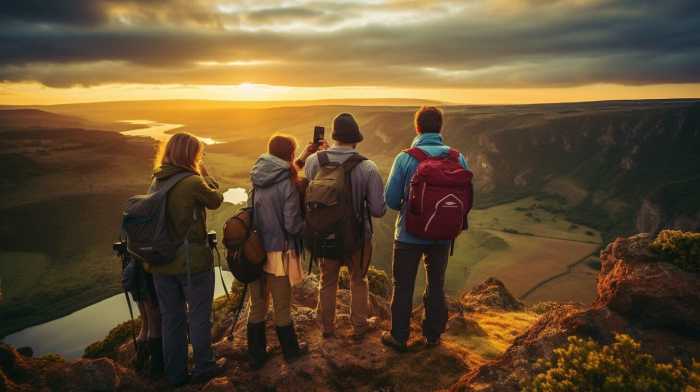
Source: lux-reviews.com
The adventure tourism sector is poised for significant growth and transformation in the coming years. Emerging technologies, evolving consumer preferences, and a growing awareness of sustainability are reshaping the landscape of adventure experiences. This evolution presents both challenges and opportunities for operators to adapt and thrive in this dynamic environment.
Remote and Off-the-Beaten-Path Experiences
The desire for unique and authentic experiences is driving a surge in demand for remote and off-the-beaten-path adventures. Tourists are increasingly seeking experiences that immerse them in untouched environments, fostering a deeper connection with nature and local cultures. This trend is particularly prevalent among millennials and Gen Z, who prioritize experiences over material possessions. Operators are capitalizing on this by developing itineraries that incorporate lesser-known destinations, partnering with local communities, and offering immersive cultural programs. This approach not only provides a more authentic experience for the traveler but also supports local economies and conservation efforts.
Technological Advancements
Technological advancements are significantly impacting the delivery and management of adventure tours. Virtual reality (VR) and augmented reality (AR) are being used to provide immersive pre-trip experiences, showcasing destinations and activities realistically and engagingly. GPS tracking, wearable technology, and mobile applications are enhancing safety and efficiency by providing real-time location updates, emergency assistance, and interactive maps. Furthermore, data analytics are allowing operators to personalize experiences, optimize itineraries, and tailor services to specific customer preferences.
Changing Consumer Preferences and Demands
Consumers are increasingly prioritizing sustainability, ethical practices, and personalized experiences in their travel choices. This means adventure tour operators need to focus on eco-friendly practices, fair labor standards, and customized itineraries that cater to individual needs. Adventure tourism is evolving from a primarily individualistic pursuit to one that emphasizes shared experiences and social responsibility. Consumers are also seeking opportunities to connect with local communities and support local economies.
Projected Future Trends and Implications
| Projected Future Trend | Potential Implications for the Industry |
|---|---|
| Rise of personalized experiences | Operators will need to tailor itineraries and activities to individual preferences, using data analytics and customer feedback. |
| Increased emphasis on sustainability and ethical practices | Operators will need to adopt eco-friendly practices, support local communities, and ensure fair labor standards. |
| Integration of technology for enhanced experiences | Operators will need to invest in VR/AR technology, GPS tracking, and mobile applications to enhance safety, efficiency, and customer engagement. |
| Growth of remote and off-the-beaten-path adventures | Operators will need to explore new destinations, partner with local communities, and offer unique and authentic experiences. |
| Focus on immersive cultural experiences. | Operators will need to collaborate with local guides and communities to offer immersive cultural experiences that respect local traditions and customs. |
Closing Summary
In conclusion, adventure tours represent a dynamic and evolving sector, driven by a blend of thrill-seeking, personal growth, and a commitment to sustainability. From meticulous planning and rigorous safety protocols to innovative marketing strategies and environmentally conscious practices, the industry continually adapts to meet the evolving needs and expectations of participants. The future of adventure tourism promises exciting developments, further enriching the human connection with the natural world.
